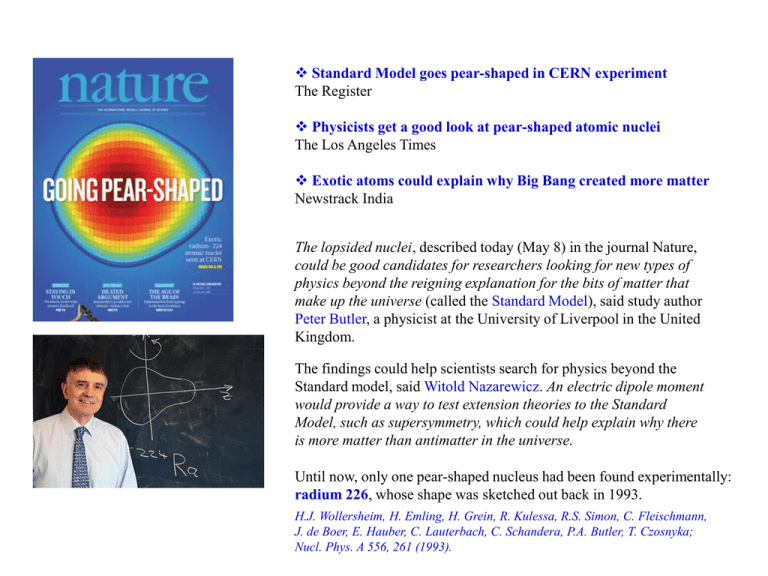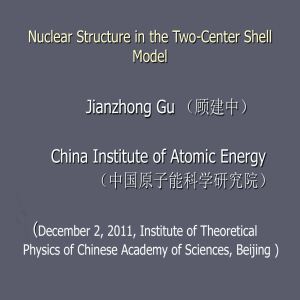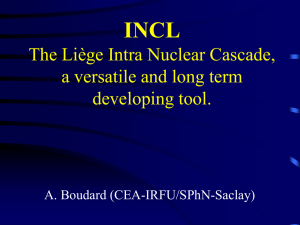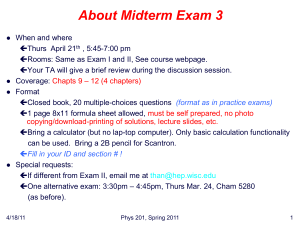226 Ra
advertisement

Standard Model goes pear-shaped in CERN experiment The Register Physicists get a good look at pear-shaped atomic nuclei The Los Angeles Times Exotic atoms could explain why Big Bang created more matter Newstrack India The lopsided nuclei, described today (May 8) in the journal Nature, could be good candidates for researchers looking for new types of physics beyond the reigning explanation for the bits of matter that make up the universe (called the Standard Model), said study author Peter Butler, a physicist at the University of Liverpool in the United Kingdom. The findings could help scientists search for physics beyond the Standard model, said Witold Nazarewicz. An electric dipole moment would provide a way to test extension theories to the Standard Model, such as supersymmetry, which could help explain why there is more matter than antimatter in the universe. Until now, only one pear-shaped nucleus had been found experimentally: radium 226, whose shape was sketched out back in 1993. H.J. Wollersheim, H. Emling, H. Grein, R. Kulessa, R.S. Simon, C. Fleischmann, J. de Boer, E. Hauber, C. Lauterbach, C. Schandera, P.A. Butler, T. Czosnyka; Nucl. Phys. A 556, 261 (1993). The Standard Model describes four fundamental forces or interactions „If equal amounts of matter and antimatter were created at the Big Bang, everything would have been annihilated, and there would be no galaxies, stars, planets or people“ (Tim Chupp Univ. Michigan) I II III Three Generations of Matter Force Carriers Gauge bosons Leptons Quarks Elementary Particles Shape parameterization R , R0 1 Y , 0 axially symmetric quadrupole =2 20≠0, 2±1= 2±2= 0 axially symmetric octupole =3 30≠0, 3±1,2,3 = 0 20≠0, 2±1,2 = 0 Octupole collectivity Y30 coupling (W.u.) Δℓ=3 Δj=3 226 88 B E 3; 0 3 Ra 138 9 Z 2 R6 2 3 16 2 some subshells interact via the r3Y30 operator R.H. Spear At. Data and Nucl. Data Tables 42 (1989), 55 e.g. in light actinide nuclei one has an interaction between j15/2 and g9/2 neutron orbitals i13/2 and f7/2 proton orbitals Octupole collectivity Octupole correlations enhanced at the magic numbers: 34, 56, 88, 134 Microscopically … Intruder orbitals of opposite parity and ΔJ, ΔL = 3 close to Fermi level 226Ra close to Z=88 N=134 f 7 / 2 i13/ 2 g9 / 2 j15 / 2 Octupole collectivity 226Ra + + + 226Ra + + In an octupole deformed nucleus the center of mass and center of charge tend to separate, creating a non-zero electric dipole moment. The double oscillator V 2 2 V0 2 H a E 3 2 B 32 a 2 V0 -a a 2V 1 2 V0 0 1 Eeven even e 2 2 Eodd 2V 1 2 V0 0 1 odd e 2 2 β3 β3 octupole deformed octupole vibrational Merzbacher ‘Quantum Mechanics’ Coulomb excitation impact parameter scattering angle d i f dcm Pi f 2 d E 2 d Ruth dcm A A 4.819 1 1 12 EMeV BE 2; I i I f dfE 2 , b A2 Z 2 Scattered α-spectrum of 226Ra (t = 1600 yr) 1/2 0+ counts → 226Ra Eα = 16 MeV θlab = 1450 2+ 3- 4He 4+ 226Ra-target beam direction Si-detector channel number λ M E 0 eb /2 Pi f βλ (exp) βλ (theo) 2 2.27 (3) 0.165 (2) 0.164 3 1.05 (5) 0.104 (5) 0.112 4 1.04 (7) 0.123 (8) 0.096 d i f d el 226Ra: d i f d Ruth t1/2= 1600 yr Scattered α-spectrum of 0+ counts 4He → 226Ra Eα = 16 MeV θlab = 1450 2+ 3- 226Ra 4+ 226Ra-target beam direction Si-detector channel number λ 2 M E 0 2.27 (3) eb /2 βλ (exp) βλ (theo) 0.165 (2) 0.164 3 1.05 (5) 0.104 (5) 0.112 4 1.04 (7) 0.123 (8) 0.096 4+ If E2 2+ In E2 Ii E4 0+ Experimental set-up PPAC ring counter 150≤ΘL≤450, 00≤φL≤3600 4 PPAC counter 226Ra 226RaBr 2 530≤ΘL≤900, 00≤φL≤840 (400 μg/cm2) on C-backing (50 μg/cm2) and covered by Be (40 μg/cm2) Coulomb excitation of 226Ra γ-ray spectrum of 226Ra 208Pb → 226Ra Elab = 4.7 AMeV counts 150 ≤ θlab ≤ 450 00 ≤ φlab ≤ 3600 energy [keV] γ-ray spectrum of 224Ra 224Ra → 60Ni / 120Sn Elab = 2.83 AMeV Signature of an octupole deformed nucleus R R0 1 2 Y20 3 Y30 4 Y40 π: + π: - 226 88 Ra β2= 0.16 β3=-0.11 β4= 0.10 E2 Single rotational band with spin sequence: I = 0 +, 1 - , 2 +, 3 - , … excitation energy E ~ I·(I+1) competition between intraband E2 and interband E1 transitions E1 transition strength 10-2 W.u. E1 Signature of an octupole deformed nucleus π: + π: - E2 224Ra Observation of unexpectedly small E1 moments in 224Ra, R.J. Poynter, P.A. Butler et al., Phys. Lett. B232 (1989), 447 E1 Signature of an octupole deformed nucleus Energy displacement δE between the positive- and negative-parity states if they form a single rotational band E I 1 E I 1 E I E I 2 2 for rigid rotor 2 W. Nazarewicz et al.; Nucl. Phys. A441 (1985) 420 Electric transition quadrupole moments in 226Ra negative parity states positive parity states rigid rotor model: I 2 M E 2 I 15 I I 1 Q2 e 32 2I 1 liquid drop: Q2 3 Z R02 2 0.36022 0.33632 0.32842 0.9672 4 fm2 5 Q2(exp) = 750 fm2 β2 = 0.21 Q2(theo) = 680 fm2 H.J. Wollersheim et al.; Nucl. Phys. A556 (1993) 261 W. Nazarewicz et al.; Nucl. Phys. A467 (1987) 437 Static quadrupole moments in 226Ra negative parity states positive parity states rigid rotor model: QS I Q0 I M E 2 I I 2 I 1 I 1 2 I 1 2 I 3 21 M E 2 01 rigid triaxial rotor model: Qs 21 6 cos3 Q0 7 9 8 sin 2 3 H.J. Wollersheim et al.; Nucl. Phys. A556 (1993) 261 Davydov and Filippov, Nucl. Phys. 8, 237 (1958) Electric transition octupole moments in 226Ra liquid drop: β3 3 Z R03 Q3 3 0.841 2 3 0.7693 4 fm3 7 0.18 0.12 0.10 MeV 0.06 I 7 0.1 β3 0 35 I I 1 I 2 I 3 M E3 I Q e 2I 3 2I 3 3 32 21 I 1 M E3 I 32 I 1 I I 1 Q e 2I 3 2I 3 3 - 0.1 0.15 MeV 0.1 I 13 I 15 β3 0 I 13 - 0.1 0.16 β2 H.J. Wollersheim et al.; Nucl. Phys. A556 (1993) 261 W. Nazarewicz et al.; Nucl. Phys. A467 (1987) 437 Electric transition octupole moments in 224Ra Intrinsic electric dipole moments in 226Ra liquid-drop contribution: Q1LD CLD A Z 2 3 1.458 34 with CLD 5.2 104 fm rigid rotor model: I 1 M E1 I H.J. Wollersheim et al.; Nucl. Phys. A556 (1993) 261 3 I Q1 e 4 G. Leander et al.; Nucl. Phys. A453 (1986) 58 Intrinsic electric dipole moments in 226Ra liquid-drop contribution: Q1LD CLD A Z 2 3 1.458 34 with CLD 5.2 104 fm 224Ra: Q1 (e fm) Iπ 1989 2013 3- 0.027(3) 0.031(6) 5- 0.040(10) 0.028(9) 7- < 0.05 < 0.08 G. Leander et al.; Nucl. Phys. A453 (1986) 58 Collective parameters In general, R , R0 1 Y* , forbidden – density change! λ=0 forbidden – CM moves! λ=1 time OK... λ=2 λ=3 Center of mass conservation 0 x d 0 o y d 0 r d 0 z d 0 1 3 z m 0 2 r Y1m , 3 x iy m 1 2 The coordinates (x, y, z) can be expressed by 4 0 r Y10 , d r 3 dr Y10 d 3 R04 0 1 4 *1m1Y1m1 6 *1m1 *2 m2 Y1m1Y 2 m2 Y10 d 4 1m1 1m1 2 m2 0 4 6 * 10 1m1 2 m2 * 1m1 * 2 m2 2 1 2 2 1 3 1 4 3 2 1 2 2 1 3 *1m1 *2m2 1 2 1m1 2 m2 4 1/ 2 * 10 1/ 2 1 0 1 0 2 0 2 0 1 1 0 m1 1 1 0 m1 2 m2 2 m2 1 0 1 0 The dipole coordinate is not an independent quantity. It is non-zero for nuclear shapes with both quadrupole and octupole degrees of freedom. 3 9 3 12 3 4 1 2 3 4 4 63 35 3 5 7 3 1 2 4 1/ 2 2 2 3 1 2 3 3 2 0 0 0 2 3 1 3 0 0 0 35 Intrinsic electric dipole moment Q1LD e z proton d 4 e p r 3 dr Y10 , d 3 The local volume polarization of electric charge can be derived from the requirement of a minimum in the energy functional. (Myers Ann. of Phys. (1971)) proton neutron 1 e VC r proton neutron 4CLD 2 3 r 3 1 r Ze Y 0 VC r 2 2 R0 1 2 1 R0 R 0 where ρp and ρn are the proton and neutron densities, CLD is the volume symmetry energy coefficient of the liquid drop model and VC is the Coulomb potential generated by ρp inside the nucleus (r < R0) p 0 4 CLD e VC r n 0 p n p 0 1 1 e VC r 2 4 CLD 2 3 3 1 r 2 r Ze 3 r 3 r VC r 1 Y10 2 Y20 3 Y30 5 R0 7 R0 2 2 R0 R0 R0 Keeping the center of gravity fixed, the integral 0 0 r 3 dr Y10 d 1 3 9 2 3 4 35 Intrinsic electric dipole moment Q1LD 4 1 e 0 1 e VC r r 3 dr Y10 , d 3 2 4CLD Q 2 2 3 4 3 3 A 1 Z 3 r 3 r 3 1 r r 3 e Y Y Y 1 10 2 20 3 30 r dr Y10 d 3 3 8 R0 4CLD R0 2 2 R0 R0 5 R0 7 R0 Q1LD 3 R04 2 1 4 1Y10 2Y20 3Y30 6 1Y10 2Y20 3Y30 Y10 d 2 44 1 R0 1 6 Y Y Y 15 Y Y Y 2 Y d 1 10 2 20 3 30 1 10 2 20 3 30 10 2 6 4 3 3 A 1 Z R04 e 1Y10 5 1Y10 2Y20 3Y30 1Y10 Y10 d 3 3 8 R0 4CLD R0 5 3 R04 2Y20 6 1Y10 2Y20 3Y30 2Y20 Y10 d 5 6 4 3 R0 Y 7 Y Y Y Y Y d 3 30 1 10 2 20 3 30 3 30 10 7 7 Q1LD 3 R04 41 6 21 2Y10Y20 2 2 3Y20Y30 Y10 d 2 44 1 R0 6 15 2 Y Y 2 Y Y Y d 1 1 2 10 20 2 3 20 30 10 2 6 4 3 3 A 1 Z R4 e 0 1 5 1 2Y10Y20 Y10 d 3 3 8 R0 4C LD R0 5 3 R04 6 1 2Y10Y20 2 3Y20Y30 Y10 d 5 6 4 3 R0 7 2 3Y20Y30 Y10 d 7 7 LD 1 Intrinsic electric dipole moment 2 57 3 2 3 1 Y Y Y d 20 30 10 4 0 0 0 Q1LD 3 4 3 35 3 9 3 3 2 3 1 2 4 35 2 5 3 3 1 2 1 2 4 35 2 3 4 3 3 A Z 1 e 1 3 32 C LD 5 3 3 3 5 4 35 2 3 3 3 3 2 3 7 4 35 Q1LD e3 3 A Z 60 2 3 32 CLD 35 35 Q1LD 0.01245 e A Z 2 3 CLD fm CLD ≈ 20 MeV Summary single rotational band for I 10 no backbending observed β2, β3, β4 deformation parameters are in excellent agreement with calculated values octupole deformation is three times larger than in octupolevibrational nuclei equal transition quadrupole moments for positive- and negativeparity states static quadrupole moments are in excellent agreement with an axially symmetric shape electric dipole moments are close to liquid-drop value ( I 10 ) octupole deformation seems to be stabilized with increasing rotational frequency Coulomb excitation of 226Ra 226Ra target broken after 8 hours Christoph Fleischmann





